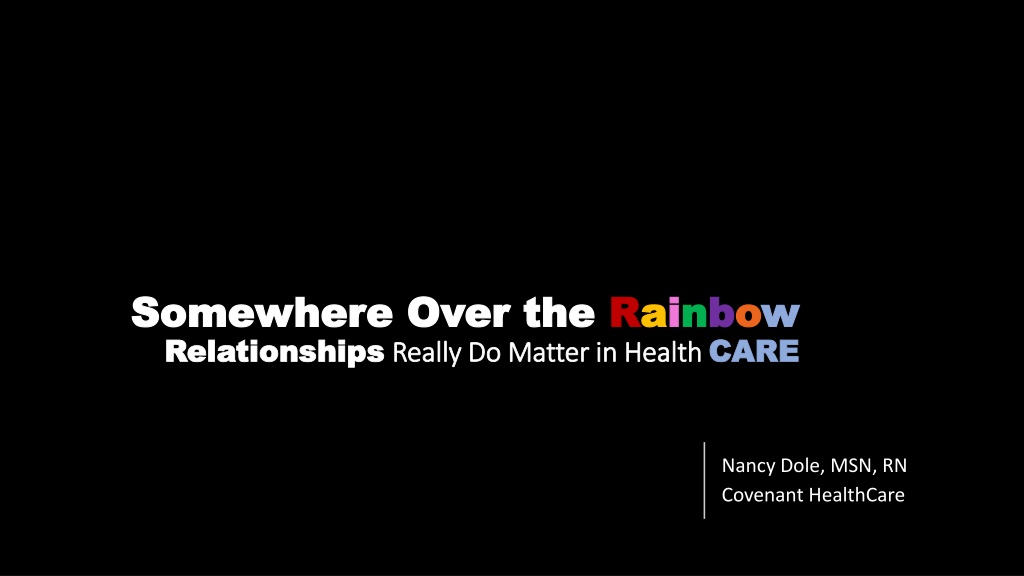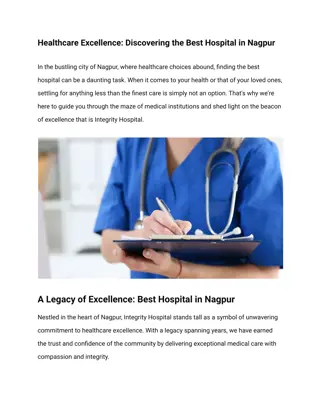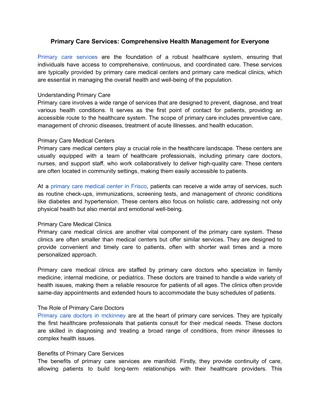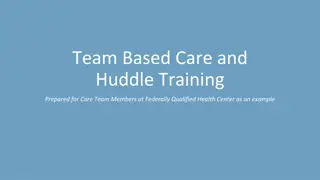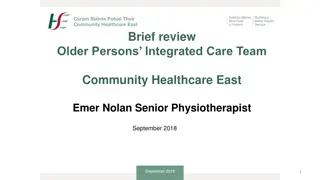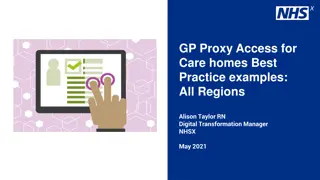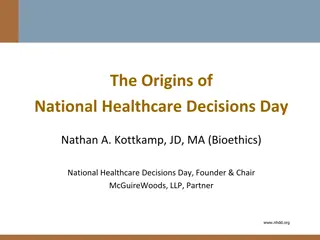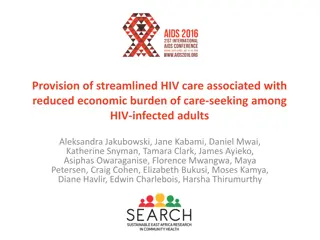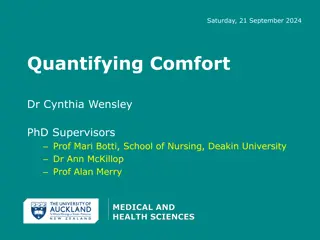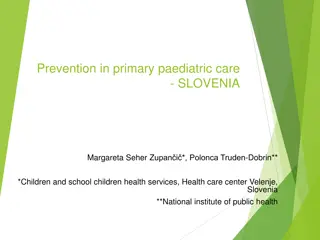Importance of Relationship-Based Care in Healthcare
Relationship-Based Care (RBC) is a vital blueprint for enhancing safety, quality, and patient experience in healthcare. It emphasizes the significance of therapeutic relationships with oneself, colleagues, and patients/families. By fostering compassion, mutual respect, and commitment to healing, RBC aims to create a caring and healing environment where patients are treated with dignity. Practicing attunement, curiosity, and presence further strengthens the therapeutic relationship between healthcare providers and patients.
Download Presentation

Please find below an Image/Link to download the presentation.
The content on the website is provided AS IS for your information and personal use only. It may not be sold, licensed, or shared on other websites without obtaining consent from the author. Download presentation by click this link. If you encounter any issues during the download, it is possible that the publisher has removed the file from their server.
E N D
Presentation Transcript
Somewhere Over the Somewhere Over the R Ra ai in nb bo ow Relationships Relationships Really Do Matter in Health Really Do Matter in Health CARE w CARE Nancy Dole, MSN, RN Covenant HealthCare
Objectives Objectives Define Relationship-Based Care Describe how creating a therapeutic relationship promotes healing Discuss how relationships among the team affects patient outcome Express how care of self enhances the care of others
Relationship Based Care (RBC) is an operational blueprint for improving safety, quality, the patient experience, employee engagement, and financial performance. Care is provided through relationships. The three key relationships: relationship with self, with colleagues, and with patients/families at the very center. Definition Structures, processes, and relationships are designed to support every team member s ability to provide attuned, compassionate, high quality care.
Patient Centric Care Patient Centric Care Relationship-Based Care (RBC) Caring and Healing Environment Leadership Teamwork Professional Practice Care Delivery Resources Outcomes
Regard for the dignity of human beings Relationship of mutual respect among health care providers Shared commitment to healing Putting caring Theories into practice Being sick puts a person in a non- ordinary state Casual diminishment of patients occur: routinization and task focused speed and productivity, technology and objectifying A disease never occurs outside the context of the person Caring and Healing Caring and Healing Environment Environment
Compassion is not a virtue it is a commitment. Its not something we have or don t have it s something we choose to practice. Brene Brown
Presence through Attunement- when a connection is made because each person experiences the other as being present Wondering- curiosity, openness, acceptance and suspending you own agenda Following- paying attention to cues and going where the other person takes you Holding-affirming what the other has taught us with an intense focus on them, providing a sense of safety Nature of the Therapeutic Relationship
Relationship-Based Teams Patients are safer if we take time to make the human connection necessary to understand fully what is going on Lack of relational proficiency is at the center of most medical errors and injuries Healing occurs when teams hold patients and families in the center of care
Kahoot.it Access the Web Browser on your smart phone
Who is the most Relationally Proficient person that you work with? What does that look like to you? Genuinely curious Adept at focusing deeply - attuning the person Gets to the core of understanding an issue Do you really feel it is necessary in health care? It is not only necessary, it is required for even adequate care to occur
Attunement The practice of being present in the moment and tuning in to members of the team. Attunement is truly the DOORWAY to HUMAN CONNECTION To listen and really hear It can be taught Not personality dependent Requires mindfulness
The most basic and powerful way to connect to another person is to listen. Just listen. Rachel Naomi Remen, best selling author and professor of Integrative Medicine Advancing Relationship-Based Cultures This Photo by Unknown Author is licensed under CC BY-NC-ND
The practice of being genuinely interested in team members, what each person contributes, and open to what you can learn from them without assumptions and judgement. Wondering in relationships is guided by Questioning ourselves and each other Seeking to understand - ask Pausing to consider whether the whole team is involved Are we together doing what is best for our patient? Wondering
The practice of listening to and focusing on what a team member is teaching us about what matters to them, and allowing that information to guide our interactions with them. Do we allow the team members input Are we reading the situation correctly? Are we attuned with all of our senses? Following
Holding The practice of intentionally creating psychological safety within the team by demonstrating respect, caring & support while allowing all voices to be heard. Holding in teams is based upon TRUST
www.christineporath.com/assess-yourself/ Studied the effects of incivility on people: Disrespect, rudeness, offensive jokes, texting during meetings Witnessing the incivility of others decreases performance, effects emotions, motivation and even how WE treat others! Why being nice to your co-workers is good for business Christine Porath, U of Nevada Ted Talk Incivility affects performance & the bottom line 66% cut back work efforts 25% admitted to taking their frustration out on customers (patients) 80% lost time worrying 12% left the job
Incivility Christine Porath Thank others Attune Greet & Smile! Share credit Even reading negative words increases the likelihood of errors X5 Bother Interrupt Obnoxious Lift others up!
Becker's Hospital Review Logo 2015 study Nearly 18 percent of newly licensed registered nurses leave their first nursing job within the first year, and roughly 34 percent leave within two years, which can be costly for hospitals. WHY? Strained relationships among nurses in a unit or between nurses and their manager or physicians. Thirty percent of nurses working in hospitals say they feel the incivility (bullied) at work. Nurses feel bullied by a variety of people, including senior management (13 percent), fellow nurses being cliquey or rude (11 percent), nursing administration and leaders (5 percent) and physicians (5 percent). "Maintaining a positive workplace culture in our hospitals not only fosters better job satisfaction, it can also improve a nurse's performance and subsequently, even enhance patient outcomes,"
Interdependent Teamwork is the most statistically significant predictor of quality as perceived by patients, families, staff, and doctors. E.C. Murphy Diverse Team members define and embrace a shared purpose create an energy together with each unique area of expertise. Teamwork Teamwork
Four Components of Successful Teams Teamwork Teamwork Trust Mutual Respect Consistent and Visible Support Open and Honest Communication
Teamwork Teamwork Trust Functional Trust: Can they do the job required of them? Trustworthiness: Relationships are built based upon character and competence
Mutual Respect Teamwork Teamwork People are accepted and treated with positive regard for who they are, not what they represent by title, position or educational level Co-workers = Colleagues I define connection as the energy that exists between people when they feel seen, heard, and valued; when they can give and receive without judgment; and when they derive sustenance and strength from the relationship. Bren Brown This Photo by Unknown Author is licensed under CC BY-SA-NC
Consistent and Visible Support Can count on each other when things go well, and when they don t. A mutual commitment for a positive outcome, to learn and grow together Teamwork Teamwork
Teamwork Teamwork Open and Honest Communication Being direct and truthful Send the message to the correct person Ask for what you need Be true to yourself Vulnerability is not winning or losing; it s having the courage to show up and be seen when we have no control over the outcome. Vulnerability is not weakness; it s our greatest measure of courage. Bren Brown, Rising Strong: How the Ability to Reset Transforms the Way We Live, Love, Parent, and Lead This Photo by Unknown Author is licensed under CC BY-NC-ND
To Care for Others we Must Care for Ourselves Jean Watson Caring Theory Nurses often become pained and worn down by trying to always care, give and be there for others without attending to the loving care needed for self. Permission to say NO Put yourself first Self Care How do you practice self-care?
Kahoot.it Kahoot.it Access the Web Browser on your smart phone
CULTURE IS EVERYTHING In a culture based upon relationships, teams are connected with the purpose and meaning of their work and take ownership for providing quality care and service All members are valued for their contributions and supported in reaching their full potential Research proves a RBC culture has a positive impact on the patient related to safety, quality & healthcare experience Relationship- Based Cultures
2017 Bureau of Labor Statistics There are 11.8 million workers employed in healthcare: practitioner, technical, and support occupations. Of those 2.9 million are registered nurses the largest occupation (25%) Hospital Culture Covenant has approximately 4750 employees 1200 of them are RNs (25%)
Relationships Relationships & Hospital Culture: & Hospital Culture: Who Shapes it? Who Shapes it? The role of the nurse is a culturally significant one. Americans ranked the nursing profession as the most honest and ethical. Molly Gamble, Becker's Healthcare | Editor- in-Chief, Becker's Hospital Review Who sets the tone of the workplace culture? You Do! NURSES LEAD THE WAY!
References References References Brown, B. (2010). The gifts of imperfection. Center City, MN: Hazelden. Brown, B. (2012). Daring greatly. New York, NY: Penguin Random House. Headley, J. (2013). It s not about the nail. https://www.youtube.com/watch?v=-4EDhdAHrOg. Koloroutis, M. (2004). Relationship-based care: A model for transforming practice. Minneapolis, MN: Creative Health Care Management. Koloroutis, M. & Abelson, D. (2017). Advancing relationship-based cultures, Minneapolis, MN: Creative Health Care Management. Koloroutis, M. & Trout, M. (2012). See me as a person: Creating therapeutic relationships with patients and their families. Minneapolis, MN: Creative Health Care Management. Porath, C. (2016). Mastering civility: A manifesto for the workplace. New York: Little, Brown & Co. Swanson, K. (1991). Empirical development of a middle range theory of caring. Nurse Research, 40(3):161-166. Watson, J. (2008). Nursing: The philosophy and science of caring. Boulder, CO: University Press. of Colorado. .
